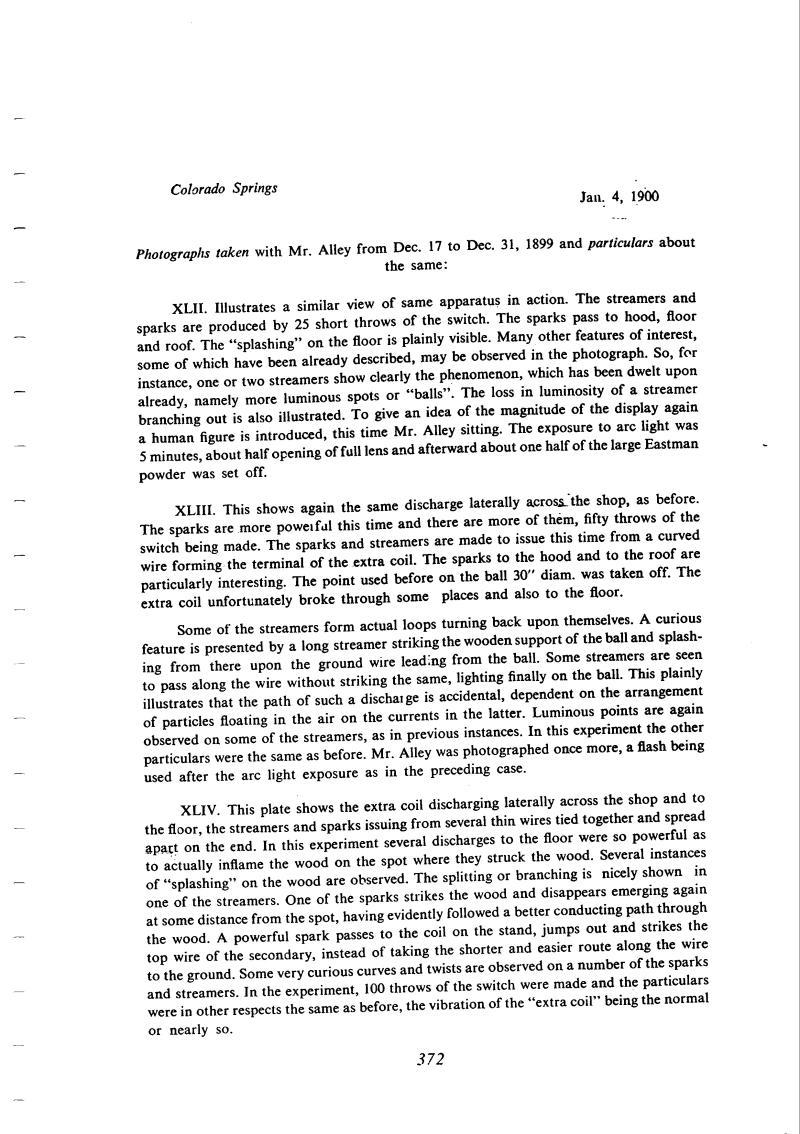Colorado Springs
Jan. 4, 1900
Photographs taken with Mr. Alley from Dec. 17 to Dec. 31, 1899 and particulars about the same:
XLII. Illustrates a similar view of same apparatus in action. The streamers and sparks are produced by 25 short throws of the switch. The sparks pass to hood, floor and roof. The âsplashingâ on the floor is plainly visible. Many other features of interest, some of which have been already described, may be observed in the photograph. So for instance, one or two streamers show clearly the phenomenon, which has been dwelt upon already, namely more luminous spots or âballsâ. The loss in luminosity of a streamer branching out is also illustrated. To give an idea of the magnitude of the display again a human figure is introduced, this time Mr. Alley sitting. The exposure to arc light was 5 minutes, about half opening of full lens and afterward about one half of the large Eastman powder was set off.
XLIII. This shows again the same discharge laterally across the shop, as before. The sparks are more powerful this time and there are more of them, fifty throws of the switch being made. The sparks and streamers are made to issue this time from a curved wire forming the terminal of the extra coil. The sparks to the hood and to the roof are particularly interesting. The point used before on the ball 30" diam. was taken off. The extra coil unfortunately broke through some places and also to the floor.
Some of the streamers form actual loops turning back upon themselves. A curious feature is presented by a long streamer striking the wooden support of the ball and splashing from there upon the ground wire leading from the ball. Some streamers are seen to pass along the wire without striking the same, lighting finally on the ball. This plainly illustrates that the path of such a discharge is accidental, dependent on the arrangement of particles floating in the air on the currents in the latter. Luminous points are again observed on some of the streamers, as in previous instances. In this experiment the other particulars were the same as before. Mr. Alley was photographed once more, a flash being used after the arc light exposure as in the preceding case.
XLIV. This plate shows the extra coil discharging laterally across the shop and to the floor, the streamers and sparks issuing from several thin wires tied together and spread apart on the end. In this experiment several discharges to the floor were so powerful as to actually inflame the wood on the spot where they struck the wood. Several instances of âsplashingâ on the wood are observed. The splitting or branching is nicely shown in one of the streamers. One of the sparks strikes the wood and disappears emerging again at some distance from the spot, having evidently followed a better conducting path through the wood. A powerful spark passes to the coil on the stand, jumps out and strikes the top wire of the secondary, instead of taking the shorter and easier route along the wire to the ground. Some very curious curves and twists are observed on a number of the sparks and streamers. In the experiment, 100 throws of the switch were made and the particulars were in other respects the same as before, the vibration of the âextra coilâ being the normal or nearly so.
372


